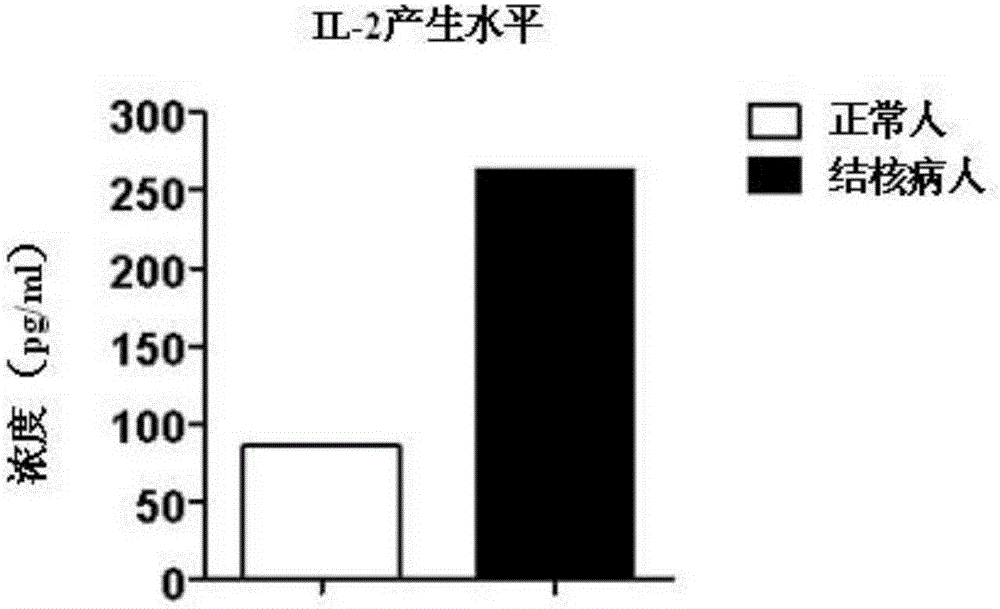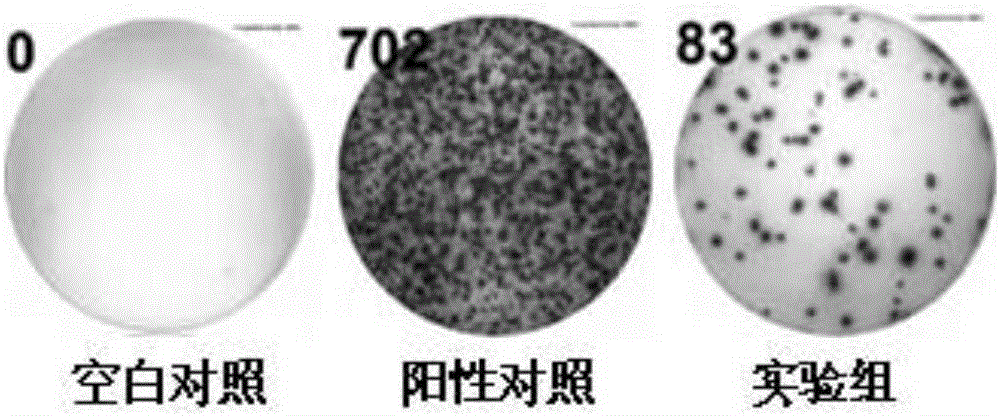Fusion protein for inducing peripheral blood mononuclear cells to produce tuberculosis specific cytokines
A fusion protein and protein technology, applied in the protein field of molecular biology technology, can solve the problems of low specificity of PPD, and achieve the effects of strong sensitivity, improved specificity and induction effect, and efficient effect.
- Summary
- Abstract
- Description
- Claims
- Application Information
AI Technical Summary
Problems solved by technology
Method used
Image
Examples
Embodiment 1
[0040] Embodiment 1: the construction of CFP-10-ESAT-6-EspC fusion protein target gene synthesis and prokaryotic expression vector
[0041] The genes encoding CFP-10, ESAT-6 and EspC proteins are respectively cfp-10 Gene ID: 886194, esat-6 Gene ID: 862098, espC Gene ID: 885770. Primers were designed using the full sequence or the partial functional region sequence expressing the antigenic activity.
[0042] 1) Use the upstream and downstream primers of CFP10, ESAT-6 and EspC to amplify the target fragments of CFP-10, ESAT-6 and EspC by PCR respectively, use TaqDNA polymerase to perform PCR amplification and recover the above fragments.
[0043]2) Two kinds of nucleotide chains with connecting peptide nucleotide sequences were synthesized by artificial synthesis, and one of the nucleotide chains (hereinafter referred to as connecting peptide chain 1) contained CFP-10 and ESAT-6 parts at both ends Sequence, the middle is the base sequence of the connecting peptide (SEQ ...
Embodiment 2
[0046] Embodiment 2: Induced expression and purification of fusion protein CFP-10-connected peptide-ESAT-6-connected peptide-EspC
[0047] Take the correct recombinant expression bacteria identified in Example 1 above containing CFP-10-connecting peptide-ESAT-6-connecting peptide-EspC target gene fragment (its nucleic acid sequence is shown in SEQ ID NO: 2) and insert 20ml containing kana resistance In the LB medium, 37°C, 250rpm, shaking culture for 6h. Autoclave 2L of LB medium, put 500ml in each 1L Erlenmeyer flask, and divide into 4 bottles. Add 2.5ml of activated bacterial solution into each bottle, shake and culture for about 3 hours at 37°C and 250 rpm, so that the OD600 of the bacterial solution is 0.5. Put the Erlenmeyer flask into cold water, cool down the shaker, and induce after cooling. Add IPTG to each bottle to make the final concentration 0.5mM, put it into a shaker at 20°C, 200rpm, and induce for 20 hours. Centrifugation: 4°C, 5000rpm, 45min. After centr...
Embodiment 3
[0048] Example 3: Separation of human peripheral blood mononuclear cells (PBMC) by density gradient centrifugation
[0049] Use fresh heparin lithium or heparin sodium blood collection tubes or vacuum blood collection tubes to aseptically extract 4ml of peripheral venous blood from the person to be tested, and invert the blood to mix the anticoagulant and blood. Prepare two 15ml centrifuge tubes, and add physiological saline for injection and lymphocyte separation solution equal to the volume of blood collection respectively. After mixing the fresh heparin anticoagulated blood with normal saline, slowly add it into the separation solution at a uniform speed, and centrifuge at 1800g for 20min at 22°C. After centrifugation, PBMCs cells can be seen to exist in the cloudy layer. Aspirate the PBMCs cell layer into a new 15ml centrifuge tube, make up to 12ml with RPMI-1640 culture medium, and centrifuge at 600g for 10min at 22°C. Pour off the supernatant, make up to 5ml with RPMI...
PUM
 Login to View More
Login to View More Abstract
Description
Claims
Application Information
 Login to View More
Login to View More - R&D
- Intellectual Property
- Life Sciences
- Materials
- Tech Scout
- Unparalleled Data Quality
- Higher Quality Content
- 60% Fewer Hallucinations
Browse by: Latest US Patents, China's latest patents, Technical Efficacy Thesaurus, Application Domain, Technology Topic, Popular Technical Reports.
© 2025 PatSnap. All rights reserved.Legal|Privacy policy|Modern Slavery Act Transparency Statement|Sitemap|About US| Contact US: help@patsnap.com



